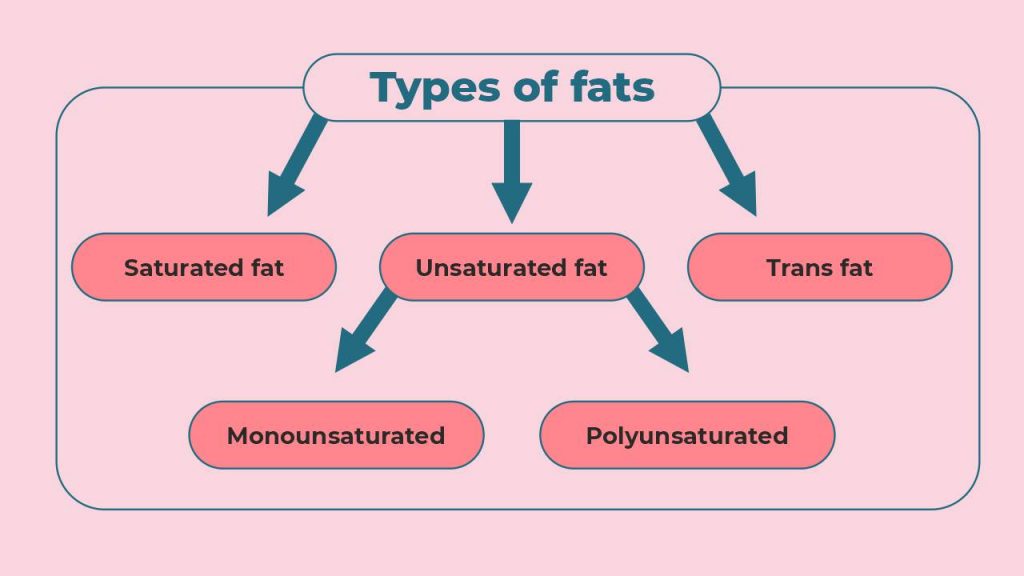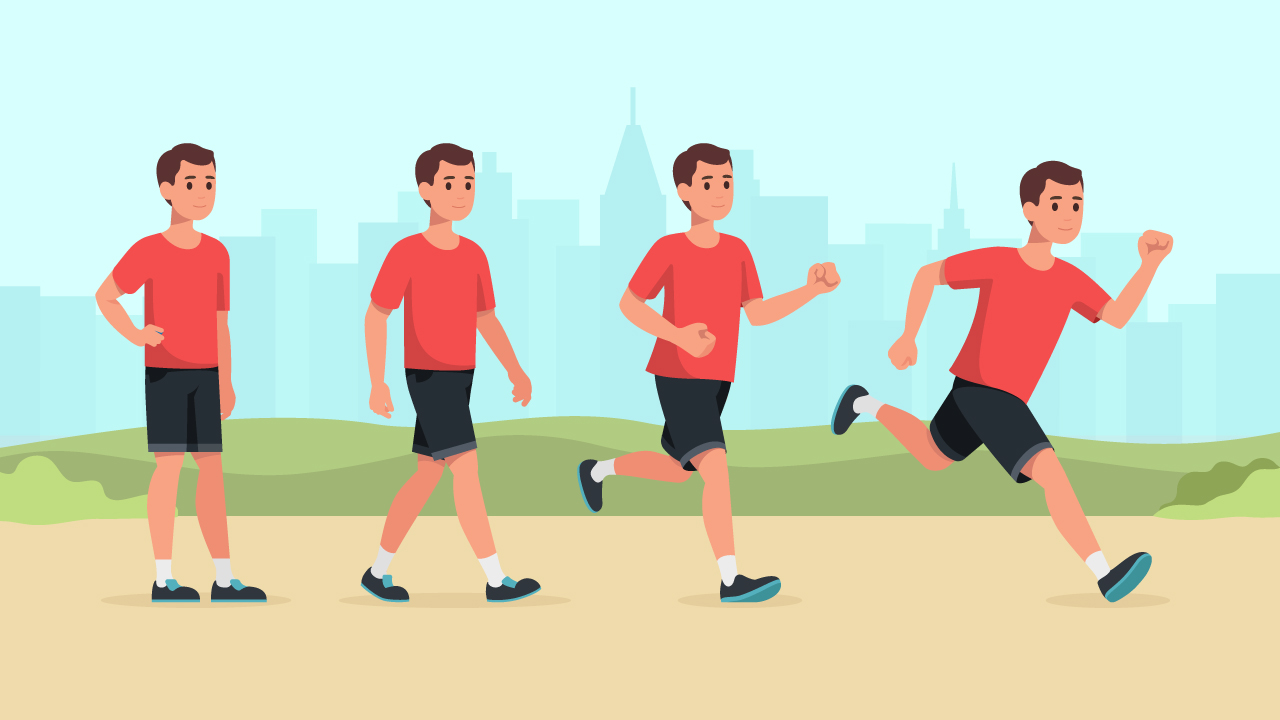
Fat and Exercise: Everything You Need to Know

Being obese and overweight is considered a health risk, and having high levels of body fat, especially around the abdomen (central adiposity), is associated with numerous health disorders such as hypertension, type-2 diabetes, metabolic syndrome, poor menstrual health, cardiovascular diseases, and arthritis. It’s no wonder then, that every year millions of people start their journey to lose fat and improve their fitness.
Understanding fat
1. Dietary fats
Lipid (from the Greek word “lipo”, meaning fat) is a group of compounds that includes oils, fats, and waxes. Almost 98% of dietary lipids exist as triglycerides, also known as simple lipids or neutral fats. All lipid-containing foods have mixtures of saturated and unsaturated fats.

Unsaturated fats, which are liquid at room temperature, contain one or more double bonds between two carbon molecules in their structure. They are considered as a beneficial source of fat as they can ease inflammation, reduce the levels of cholesterol, and improve heart-health. Based on the number of bonds present, unsaturated fats can be categorized into:
Monounsaturated fats: These contain only one double bond in the structure. They are found in foods such as olive, peanut and canola oils, avocados, almonds, hazelnuts, and pecans, pumpkin and sesame seeds.
Polyunsaturated fats: These contain two or more double bonds in their structure. They are found in foods such as sunflower, corn, soybean and flaxseed oils, walnuts, flax seeds, fish, canola oil.
Saturated fats, at the molecular level, lack double bonds between two carbon molecules since they are saturated with hydrogen molecules. Eating foods that are high in saturated fats can increase the level of cholesterol in blood, which can ultimately raise the risk of developing heart diseases. Replacing foods high in saturated fats with unsaturated fats can lower blood cholesterol and help prevent heart conditions.
Although healthy foods such as fruits and nuts contain saturated fats they are in much lesser amounts than in beef, lamb, sausages, lard and cream, butter, cheese, and whole and reduced fat milk. Plant sources include coconut oil, palm oil, and palm kernel oil.
Trans-fats are derived by heating liquid vegetable oils in the presence of hydrogen gas and a catalyst in a process called hydrogenation. They are the most harmful form of fat for the heart, blood vessels, and overall health because it raises bad cholesterol, lowers good cholesterol and is related to heart disease, diabetes, and other chronic conditions. Sources include vegetable shortenings, margarines, crackers, candies, cookies, fried foods, baked goods, salad dressings, and foods made with partially hydrogenated vegetable oils.
Also read: Dietary Fats: How To Choose Right and Eat Smart
2. Body fat
Stored body fat is different from dietary fat.
When we consume more calories than we burn, we store the excess calories in the form of fat. This excess calories can be in the form of any or all foods that we eat, not just dietary fats. Optimal level of body fat is required for health and any athletic activity.
Body fat exists in two forms or depots — essential fat and storage fat. Essential fat consists of fat in the lungs, heart, liver, spleen kidneys, intestines, muscles and tissues of the nervous systems, and bone marrow.
Storage fat includes fat (triglycerides) packed in adipose tissue. It includes the visceral tissues that protect the vital organs of the body, and the larger volume of adipose tissue is deposited beneath the skin, which is called subcutaneous fat, or the fat we can feel just under our skin.
Visceral fat is the fat stored in the abdominal cavity. Carrying high amounts of visceral fat is strongly associated with development of health complications, such as impaired insulin sensitivity, glucose intolerance, and type-2 diabetes.
Role of fats
1. Fats can provide as much as 80%-90% of the body’s energy requirements. One gram of pure fat contains 9kCal of energy. This is more than twice the energy contained in 1g of carbohydrate and protein.
2. Fats provide protection to the vital organs of the body — up to 4% of the body’s fat protects against trauma to the vital organs of the body.
3. Fats stored just below the skin in the subcutaneous fat layer provide insulation, which determines one’s ability to tolerate extremes of cold exposure. In contrast, excess body fat hinders temperature regulation, retarding the ability of the body to release heat.
4. They work as transport-medium for fat-soluble vitamins A, D, E, and K, which require an intake of 20g of dietary fat on a daily basis.
5. Dietary fat delays the onset of hunger pangs and contributes to satiety as emptying fats from the stomach takes about 3.5 hours after its ingestion.
Function of fat in exercise
The contribution of fat to exercise depends on two factors:
- Fatty acid release from triglycerides in the fat storage sites
- Delivery in the circulation to muscle tissue
In the first hour, fat supplies about 50% of the energy. By the third hour, fat contributes to up to 70% of the total energy requirement. With greater dependency on fat, exercise intensity decreases to a level governed by the body’s capacity to utilize fat for energy.
Excessive Fat-Gain, Obesity and Ways To Prevent It
Obesity begins mostly in childhood, increasing the risk for these children to become obese adults. Obesity is a result of various factors, including genetic, environmental, physiological, metabolic, behavioral, and also racial influences.
Role of exercise and nutrition
An active lifestyle plays a crucial role in maintaining healthy weight and keeping obesity and its risk factors at bay. This does not happen by doing a leisurely stroll in the park or playing a game of tennis once a month. Rather, it requires a serious commitment to include daily physical exercise in your changing schedules.
1. Physical activity in a weight-loss plan augments performance capacity, and speeds up the process of losing fat.
2. Exercise has a muscle-sparing effect. Losing fat by means of just dieting results in loss of lean tissue.
3. Aerobic exercise and strength training gives a positive spin-off to your weight-loss efforts even in the absence of caloric restrictions by improving your fat-free mass (FFM).
4. Exercise is beneficial in reducing central adiposity, which diminishes the tendency to develop insulin resistance and type-2 diabetes.
5. Performing continuous, large-muscle activities with moderate to high caloric cost such as running, multi-joint strength training, circuit training, rope skipping, cycling, swimming, and stair-stepping is recommended.
Energy consumed vs energy expenditure: Energy balance dictates that your body mass remains unchanged when caloric intake is equivalent to caloric expenditure.
Three ways you can unbalance this equation
- Reducing caloric intake below daily energy needs
- Maintaining caloric intake and increasing energy expenditure through physical exercise above your daily requirements
- Decreasing caloric intake and increasing daily energy expenditure
These are the only three ways in which you can lose fat.
Calorie deficit
Here is an example to help you understand how even a small gain in caloric intake by 100kCal per day can have a significant impact on your body mass. According to this equation, surplus calories consumed in a year equal 36,500kCal. One pound of fat contains 3,500kCal, so this caloric excess causes a yearly gain of 4.7kg of body fat.
On the contrary, if your caloric intake decreases by 100kCal and energy expenditure increases by 100kCal, then the yearly deficit equals the energy in 9.5kg of body fat.
It is recommend that obese reduce their weight by 5% to 15%. This realistic goal ensures reduction in weight-related health complications.
Guidelines
- Aim to reduce your caloric intake by 500kCal-1000 kCal below the daily expenditure.
- Consume balanced meals.
- Don’t make the mistake of reducing fats and increasing your carbohydrates and protein intake. You’d then end up consuming the same amount of calories.
- Avoid severe restriction on calories as it augments tissue loss.
- Semistarvation-type diets increase the risk of malnourishment, depletion of glycogen reserves, and loss of lean tissue.
- Weight loss occurs when energy output exceeds energy intake.
- Perform regular physical exercise.
If you are someone whose goal is to lose fat, the best approach is to reduce your caloric intake, increase energy expenditure by adding physical exercise, and make sure to eat a well-proportioned diet. And it’s best to not be tempted by any fad diets.
References
1. McArdle W, Katch F, Katch V. Essentials of exercise physiology. Philadelphia: Wolters Kluwer, 2016.
2. E.Hardman A, Jeremy N.Morris C. Physical Activity and Health. Milton: Taylor & Francis, 2003.
3. Home. Who.int. 2021. https://www.who.int (accessed 6 May 2021).
4. Baechle T. Essentials of strength training and conditioning. Champaign, IL: Human Kinetics, 2016.














